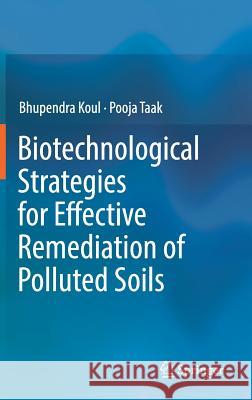Biotechnological Strategies for Effective Remediation of Polluted Soils » książka



Biotechnological Strategies for Effective Remediation of Polluted Soils
ISBN-13: 9789811324192 / Angielski / Twarda / 2018 / 240 str.
Biotechnological Strategies for Effective Remediation of Polluted Soils
ISBN-13: 9789811324192 / Angielski / Twarda / 2018 / 240 str.
(netto: 575,06 VAT: 5%)
Najniższa cena z 30 dni: 578,30
ok. 22 dni roboczych
Dostawa w 2026 r.
Darmowa dostawa!
This book presents a comprehensive collection of various in situ and ex-situ soil remediation regimes that employ natural or genetically modified microbes, plants, and animals for the biodegradation of toxic compounds or hazardous waste into simpler non-toxic products.
Chapter 1. Soil pollution: causes and consequences.- Chapter 1.1. Introduction.- Chapter 1.2. Causes of soil pollution.- Chapter 1.2.1. Natural sources.- Chapter 1.2.1.1. Volcanic eruptions.- Chapter 1.2.1.2. Earthquakes.- Chapter 1.2.1.3. Alterations in rainfall patterns.- Chapter 1.2.1.4. Geographical changes.- Chapter 1.2.1.5. Tsunami. .- Chapter 1.2.2. Anthropogenic sources.- Chapter 1.2.2.1. Solid wastes.- Chapter 1.2.2.2. Agricultural practices.- Chapter 1.2.2.3. Radioactive wastes.- Chapter 1.2.2.4. Chemical wastes.- Chapter 1.2.2.5. Mining and smelting.- Chapter 2. Ex situ soil remediation strategies.- Chapter 2.1. Introduction.- Chapter 2.2. Land farming.- Chapter 2.3. Biopile.- Chapter 2.4. Windrow.- Chapter 2.5. Soil washing.- Chapter 2.6. Composting.- Chapter 2.7. Bioreactor.- Chapter 2.8. Ion exchange.- Chapter 2.9. Absorption/adsorption.- Chapter 2.10. Pyrolysis.- Chapter 2.11. Ultrasonic technology.- Chapter 3. In situ soil remediation strategies.- Chapter 3.1. Physical methods.- Chapter 3.1.1. Physical remediation.- Chapter 3.1.2. Physical separation.- Chapter 3.1.3. Soil flushing.- Chapter 3.1.4. Volatilization.- Chapter 3.1.5. Froth flotation.- Chapter 3.1.6. Thermal remediation.- Chapter 3.1.6.1. Electrical resistance heating (ERH) .- Chapter 3.1.6.2. Steam injection and extraction.- Chapter 3.1.6.3.Conductive heating.- Chapter 3.1.6.4. Radio-frequency heating (RFH) .- Chapter 3.1.6.5. In situ vitrification (ISV) .- Chapter 4. Chemical methods.- Chapter 4.1. Introduction.- Chapter 4.2.Chemical leaching.- Chapter 4.3.Chemical fixation.- Chapter 4.4.Chemical oxidation.- Chapter 4.5. Electrokinetic remediation.- Chapter 4.6. Biochar and soil remediation.- Chapter 5.Introduction.- Chapter 5.1.1. Carbon sequestration.- Chapter 5.1.2. Nutrient exchange.- Chapter 5.1.3. Water holding.- Chapter 5.1.4. Adsorption/ absorption.- Chapter 5.1.5. Oxidation/reduction.- Chapter 5.2. Biochar-microbe interaction in soil.- Chapter 6. Soil remediation through microbes.- Chapter 6.1. Introduction.- Chapter 6.2. Microbial degradation of petroleum hydrocarbons.- Chapter 6.3. Bioventing.- Chapter 6.4. Bioleaching.- Chapter 6.5. Bioaugmentation.- Chapter 6.6. Mycoremediation.- Chapter 7. Soil remediation through algae, plants and animals.- Chapter 7.1. Introduction.- Chapter 7.2. Phycoremediation.- Chapter 7.3. Phytoremediation.- Chapter 7.3.1. Rhizofiltration.- Chapter 7.3.2. Transformation.- Chapter 7.3.2.1. Degradation.- Chapter 7.3.2.2. Volatilization.- Chapter 7.3.2.3. Stabilization.- Chapter 7.3.3. Phytoextraction/phytoaccumulation.- Chapter 7.3.4. Phytomining.- Chapter 7.3.5. Phytostimulation.- Chapter 7.4. Genetic engineering approaches for phytoremediation.- Chapter 7.5. Animal remediation.- Chapter 8. Nanobioremediation.- Chapter 8.1. Introduction.- Chapter 8.2. Properties of nanoparticles.- Chapter 8.3. Types of nanomaterials.- Chapter 8.3.1. TiO2 (Titanium dioxide) based nanoparticles.- Chapter 8.3.2. Iron Based Nanoparticles.- Chapter 8.3.3. Bimetallic Nanoparticles.- Chapter 8.3.4. Nanoclays.- Chapter 8.3.5. Nanotubes.- Chapter 8.3.6. Dendrimer and nanosponges.- Chapter 8.3.7. Magnetic nanoparticles 8.4. Green synthesis of nanoparticles for soil remediation.- Chapter 8.5. Nnaobioremediation.- Chapter 9. Case studies and future prospects.- Chapter 9.1. Case studies on soil remediation.- Chapter 9.2. Future prospects.
Dr Bhupendra Koul is an Assistant Professor at the School of Bioengineering and Biosciences, Lovely Professional University (LPU), Punjab, India. He was awarded a CSIR Senior Research Fellowship in 2013. During his PhD at the Plant Transgenics Lab, CSIR-National Botanical Research Institute (CSIR-NBRI) in Lucknow, he worked on the optimization, introduction and expression of modified full-length and truncated versions of Bt-cry1Ab and 1Ac genes in the tomato to develop non-chimeric and stable transgenic lines resistant to two lepidopteran insects (Helicoverpa armigera and Spodoptera litura) and evaluated the performance of both the versions of cry1Ab and 1Ac genes regarding the stability and efficacy of insecticidal toxins in transgenic plants. He has evaluated the performance and role of different cis-motifs of artificial synthetic promoters for overexpression of genes in the tomato and performed comparative in silico analyses of various cry1A genes for toxicity to target insects. He has six years of research experience and four years of teaching experience, and received the 2016 Teacher Appreciation Award for Biotechnology & Biosciences at the LPU. He designed the full-length synthetic cry1Ac gene (NCBI submission accession No.: KP195020.1; GI:768678299) and has published 14 research papers in national and international journals including BMC Genomics, Plant Physiology and Biochemistry, Springer Plus; authored three book chapters for Springer Nature; and holds one patent (No. 3177DEL2010).
Pooja Taak is currently pursuing her PhD at Lovely Professional University (LPU), Punjab, India under the guidance of Dr. Bhupendra Koul, and is an Assistant Professor at the LPU’s School of Bioengineering and Biosciences. She completed her specialization in Crop Genetics and Plant Breeding during her Master’s studies in Botany at Punjabi University Patiala; and her project training at the Biotechnology Division of the CSIR-IHBT, Palampur, India under the supervision of Dr. Kunal Singh. Presently, she is working on effective weed management strategies to enhance the yield of Stevia rebaudiana. She has also published her research findings in national and international journals.
This book presents a comprehensive collection of various in situ and ex-situ soil remediation regimes that employ natural or genetically modified microbes, plants, and animals for the biodegradation of toxic compounds or hazardous waste into simpler non-toxic products. These techniques are demonstrated to be functionally effective in connection with physical, chemical, and biological strategies.
Soil and water contamination through heavy metals, hydrocarbons and radioactive wastes is of global concern, as these factors have cumulative effects on the environment and human health through food-chain contamination. The book discusses the utilization of algae, plants, plant-associated bacteria, fungi (endophytic or rhizospheric) and certain lower animals for the sustainable bioremediation of organic and inorganic pollutants. In addition, it explores a number of more recent techniques like biochar and biofilms for carbon sequestration, soil conditioning and remediation, and water remediation. It highlights a number of recent advances in nanobioremediation, an emerging technology based on biosynthetic nanoparticles. Lastly, it presents illustrative case studies and highlights the successful treatment of polluted soils by means of these strategies.
1997-2025 DolnySlask.com Agencja Internetowa
KrainaKsiazek.PL - Księgarnia Internetowa









